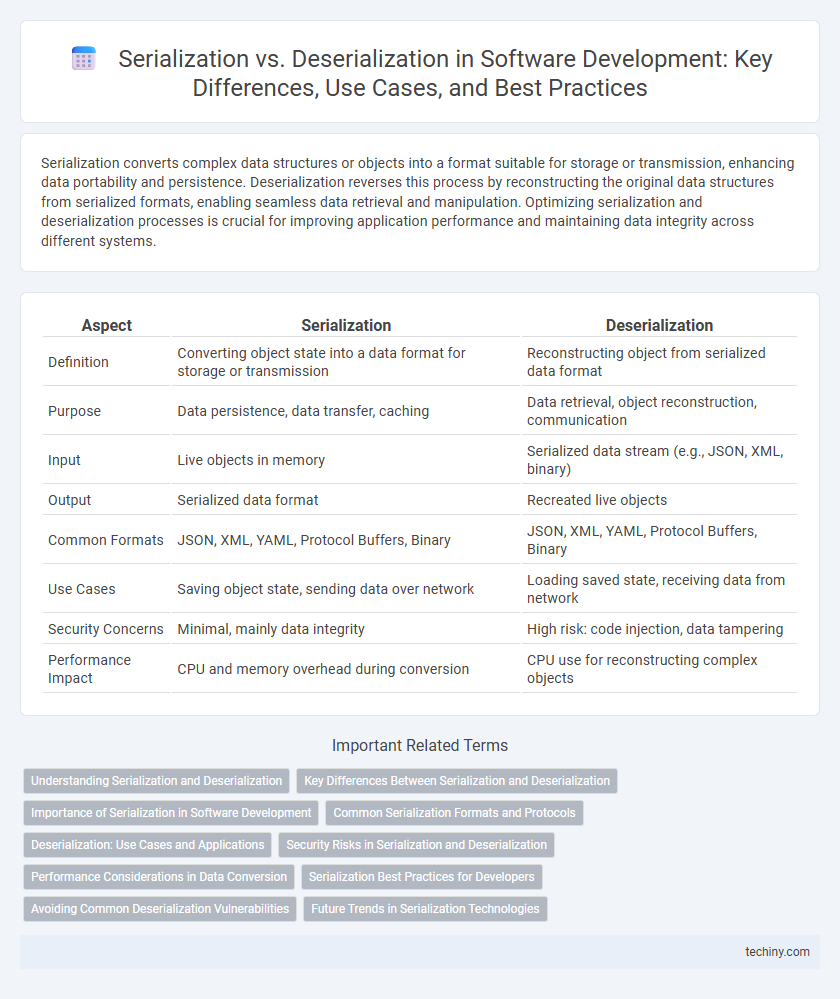Serialization converts complex data structures or objects into a format suitable for storage or transmission, enhancing data portability and persistence. Deserialization reverses this process by reconstructing the original data structures from serialized formats, enabling seamless data retrieval and manipulation. Optimizing serialization and deserialization processes is crucial for improving application performance and maintaining data integrity across different systems.
Table of Comparison
| Aspect | Serialization | Deserialization |
|---|---|---|
| Definition | Converting object state into a data format for storage or transmission | Reconstructing object from serialized data format |
| Purpose | Data persistence, data transfer, caching | Data retrieval, object reconstruction, communication |
| Input | Live objects in memory | Serialized data stream (e.g., JSON, XML, binary) |
| Output | Serialized data format | Recreated live objects |
| Common Formats | JSON, XML, YAML, Protocol Buffers, Binary | JSON, XML, YAML, Protocol Buffers, Binary |
| Use Cases | Saving object state, sending data over network | Loading saved state, receiving data from network |
| Security Concerns | Minimal, mainly data integrity | High risk: code injection, data tampering |
| Performance Impact | CPU and memory overhead during conversion | CPU use for reconstructing complex objects |
Understanding Serialization and Deserialization
Serialization converts complex data structures or objects into a format suitable for storage, transmission, or reconstruction, such as JSON, XML, or binary. Deserialization reverses this process by transforming serialized data back into a usable object or data structure within an application. Understanding serialization and deserialization is crucial for enabling data persistence, interprocess communication, and distributed system interactions in software development.
Key Differences Between Serialization and Deserialization
Serialization converts complex data objects into a format suitable for storage or transmission, such as JSON or XML, while deserialization reconstructs the original objects from this serialized format. Key differences include directionality--serialization is object to data stream, deserialization is data stream to object--and use cases like saving state versus loading state. Performance considerations also vary, with serialization often optimized for size reduction and deserialization for speed in data reconstruction.
Importance of Serialization in Software Development
Serialization converts complex data structures or objects into a format that can be easily stored or transmitted, enabling efficient data exchange between different components or systems. It plays a crucial role in distributed applications, data persistence, and caching mechanisms by preserving the state of an object for future reconstruction. Proper serialization enhances interoperability, reduces latency in communication, and ensures data integrity during transmission and storage.
Common Serialization Formats and Protocols
Common serialization formats include JSON, XML, and Protocol Buffers, each offering unique advantages in data interchange and storage. JSON excels in human-readability and web compatibility, while XML provides extensive metadata support and schema validation. Protocol Buffers deliver efficient, compact binary serialization, making them ideal for performance-critical applications and cross-language communication.
Deserialization: Use Cases and Applications
Deserialization transforms data back into usable objects, enabling seamless data exchange in distributed systems and microservices architecture. It plays a critical role in restoring application state, processing API responses, and loading configuration files during runtime. Key applications include real-time data processing, caching mechanisms, and communication between heterogeneous platforms where data integrity and compatibility are essential.
Security Risks in Serialization and Deserialization
Serialization and deserialization pose significant security risks, particularly when handling untrusted data, as attackers may exploit vulnerabilities to execute arbitrary code or trigger denial-of-service attacks. Insecure deserialization can lead to remote code execution, data tampering, and unauthorized access, especially in systems lacking proper input validation and authentication mechanisms. Implementing strict input validation, using secure libraries, and employing serialization frameworks with built-in security controls are critical steps to mitigate these threats in software development.
Performance Considerations in Data Conversion
Serialization transforms complex data structures into a format suitable for storage or transmission, while deserialization reconstructs data back into usable objects. Performance considerations in data conversion involve minimizing CPU usage and memory allocation to reduce latency, especially in high-throughput systems. Efficient serialization frameworks like Protocol Buffers or FlatBuffers optimize speed and compactness, directly impacting application responsiveness and resource consumption.
Serialization Best Practices for Developers
Serialization in software development involves converting objects into a format suitable for storage or transmission, with best practices emphasizing the use of efficient, language-agnostic formats such as JSON or Protocol Buffers. Developers should ensure secure serialization by avoiding the serialization of sensitive data and implementing strict type controls to prevent injection attacks. Optimizing serialization performance includes minimizing object graph complexity, leveraging built-in libraries for speed, and maintaining backward compatibility through versioning strategies.
Avoiding Common Deserialization Vulnerabilities
To avoid common deserialization vulnerabilities, always validate and sanitize input data before deserialization, ensuring it adheres to expected formats and types. Use secure serialization libraries that enforce strict type checks and avoid deserializing arbitrary or untrusted data to prevent remote code execution or injection attacks. Implement security measures such as input whitelisting, deserialization filters, and runtime integrity checks to harden applications against malicious payloads.
Future Trends in Serialization Technologies
Future trends in serialization technologies emphasize increased efficiency and interoperability across diverse systems, leveraging advancements in binary and JSON-based formats. Emerging protocols such as Protocol Buffers, Apache Avro, and FlatBuffers enable faster data serialization with reduced payload sizes, enhancing performance for cloud-native and microservices architectures. Innovations in schema evolution and cross-language compatibility address growing demands for flexible, scalable data exchange in distributed applications.
Serialization vs Deserialization Infographic

 techiny.com
techiny.com